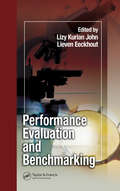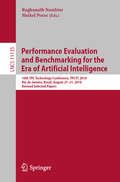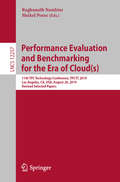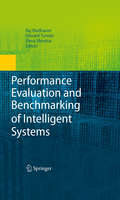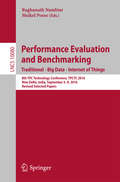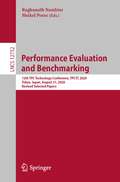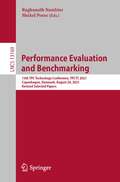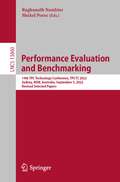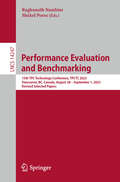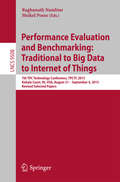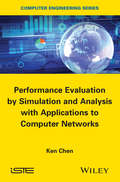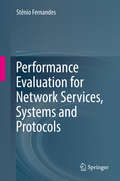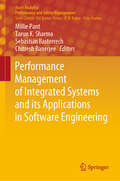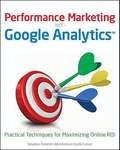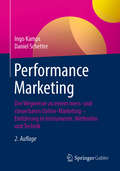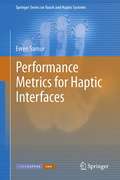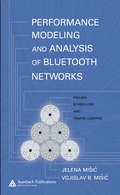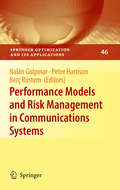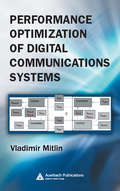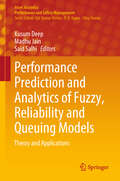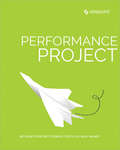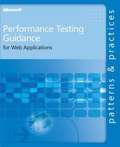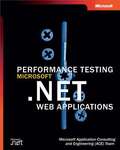- Table View
- List View
Performance Evaluation and Benchmarking
by Lizy Kurian John Lieven EeckhoutComputer and microprocessor architectures are advancing at an astounding pace. However, increasing demands on performance coupled with a wide variety of specialized operating environments act to slow this pace by complicating the performance evaluation process. Carefully balancing efficiency and accuracy is key to avoid slowdowns, and such a balance can be achieved with an in-depth understanding of the available evaluation methodologies. Performance Evaluation and Benchmarking outlines a variety of evaluation methods and benchmark suites, considering their strengths, weaknesses, and when each is appropriate to use.Following a general overview of important performance analysis techniques, the book surveys contemporary benchmark suites for specific areas, such as Java, embedded systems, CPUs, and Web servers. Subsequent chapters explain how to choose appropriate averages for reporting metrics and provide a detailed treatment of statistical methods, including a summary of statistics, how to apply statistical sampling for simulation, how to apply SimPoint, and a comprehensive overview of statistical simulation. The discussion then turns to benchmark subsetting methodologies and the fundamentals of analytical modeling, including queuing models and Petri nets. Three chapters devoted to hardware performance counters conclude the book.Supplying abundant illustrations, examples, and case studies, Performance Evaluation and Benchmarking offers a firm foundation in evaluation methods along with up-to-date techniques that are necessary to develop next-generation architectures.
Performance Evaluation and Benchmarking for the Era of Artificial Intelligence: 10th TPC Technology Conference, TPCTC 2018, Rio de Janeiro, Brazil, August 27–31, 2018, Revised Selected Papers (Lecture Notes in Computer Science #11135)
by Meikel Poess Raghunath NambiarThis book constitutes the thoroughly refereed post-conference proceedings of the 10th TPC Technology Conference on Performance Evaluation and Benchmarking, TPCTC 2018, held in conjunction with the 44th International Conference on Very Large Databases (VLDB 2018) in August 2018.The 10 papers presented were carefully reviewed and selected from numerous submissions.The TPC encourages researchers and industry experts to present and debate novel ideas and methodologies in performance evaluation, measurement, and characterization.
Performance Evaluation and Benchmarking for the Era of Cloud: 11th TPC Technology Conference, TPCTC 2019, Los Angeles, CA, USA, August 26, 2019, Revised Selected Papers (Lecture Notes in Computer Science #12257)
by Meikel Poess Raghunath NambiarThis book constitutes the refereed post-conference proceedings of the 11th TPC Technology Conference on Performance Evaluation and Benchmarking, TPCTC 2019, held in conjunction with the 45th International Conference on Very Large Databases (VLDB 2019) in August 2019.The 11 papers presented were carefully reviewed and focus on topics such as blockchain; big data and analytics; complex event processing; database Optimizations; data Integration; disaster tolerance and recovery; artificial Intelligence; emerging storage technologies (NVMe, 3D XPoint Memory etc.); hybrid workloads; energy and space efficiency; in-memory databases; internet of things; virtualization; enhancements to TPC workloads; lessons learned in practice using TPC workloads; collection and interpretation of performance data in public cloud environments.
Performance Evaluation and Benchmarking of Intelligent Systems
by Raj Madhavan Elena Messina Edward TunstelThis contributed volume is dedicated to the subject of performance evaluation and benchmarking of intelligent systems by drawing from the experiences and insights of experts gained both through theoretical development and practical implementation of intelligent systems in a variety of application domains. The chapters cover a range of applications, such as assistive robotics, planetary surveying, urban search and rescue, and line tracking for automotive assembly. Subsystems include human-robot interaction, multi-robot coordination, communications, perception, and mapping, Chapters also cover simulation support and open source software for cognitive platforms, providing examples of enabling underlying technologies that can help intelligent systems to propagate and increase in capabilities. Performance Evaluation and Benchmarking of Intelligent Systems serves as a professional reference for researchers and practitioners in a variety of fields.
Performance Evaluation and Benchmarking. Traditional - Big Data - Internet of Things
by Meikel Poess Raghunath NambiarThis book constitutes the thoroughly refereed post-conference proceedings of the 8th TPC Technology Conference, on Performance Evaluation and Benchmarking, TPCTC 2016, held in conjunction with the 41st International Conference on Very Large Databases (VLDB 2016) in New Delhi, India, in September 2016. The 9 papers presented were carefully reviewed and selected from 20 submissions. They reflect the rapid pace at which industry experts and researchers develop innovative techniques for evaluation, measurement and characterization of complex systems.
Performance Evaluation and Benchmarking: 12th TPC Technology Conference, TPCTC 2020, Tokyo, Japan, August 31, 2020, Revised Selected Papers (Lecture Notes in Computer Science #12752)
by Meikel Poess Raghunath NambiarThis book constitutes the refereed post-conference proceedings of the 12th TPC Technology Conference on Performance Evaluation and Benchmarking, TPCTC 2020, held in August 2020.The 8 papers presented were carefully reviewed and cover the following topics: testing ACID compliance in the LDBC social network benchmark; experimental performance evaluation of stream processing engines made easy; revisiting issues in benchmarking metric selection; performance evaluation for digital transformation; experimental comparison of relational and NoSQL document systems; a framework for supporting repetition and evaluation in the process of cloud-based DBMS performance benchmarking; benchmarking AI inference; a domain independent benchmark evolution model for the transaction processing performance council.
Performance Evaluation and Benchmarking: 13th TPC Technology Conference, TPCTC 2021, Copenhagen, Denmark, August 20, 2021, Revised Selected Papers (Lecture Notes in Computer Science #13169)
by Meikel Poess Raghunath NambiarThis book constitutes the refereed post-conference proceedings of the 13th TPC Technology Conference on Performance Evaluation and Benchmarking, TPCTC 2021, held in August 2021. The 9 papers presented were carefully reviewed and selected from numerous submissions. The TPC encourages researchers and industry experts to present and debate novel ideas and methodologies in performance evaluation, measurement, and characterization.
Performance Evaluation and Benchmarking: 14th TPC Technology Conference, TPCTC 2022, Sydney, NSW, Australia, September 5, 2022, Revised Selected Papers (Lecture Notes in Computer Science #13860)
by Meikel Poess Raghunath NambiarThis book constitutes the refereed post-conference proceedings the 14th TPC Technology Conference on Performance Evaluation and Benchmarking, TPCTC 2022, which was held in Sydney, NSW, Australia, on September 5, 2022.The 5 revised full papers presented were carefully selected from 12 submissions. The conference focuses on Pick and Mix Isolation Levels; Benchmarking considerations for Trustworthy and Responsible AI (Panel); Preliminary Scaling Characterization with TPCx-AI and New Initiatives.
Performance Evaluation and Benchmarking: 15th TPC Technology Conference, TPCTC 2023, Vancouver, BC, Canada, August 28 – September 1, 2023, Revised Selected Papers (Lecture Notes in Computer Science #14247)
by Meikel Poess Raghunath NambiarThis book constitutes the refereed post-conference proceedings from the 15th TPC Technology Conference on Performance Evaluation and Benchmarking, TPCTC 2023, held in Vancouver, British Columbia, Canada, during August 28 – September 1, 2023. The 9 full papers included in this book were carefully reviewed and selected from 17 submissions. These papers focus on various novel ideas and methodologies for Performance evaluation and Benchmarking in emerging technology areas.
Performance Evaluation and Benchmarking: Traditional to Big Data to Internet of Things
by Meikel Poess Raghunath NambiarThis book constitutes the thoroughly refereedpost-conference proceedings of the 7th TPC Technology Conference on PerformanceEvaluation and Benchmarking, TPSTC 2015, held in conjunction with the 40thInternational Conference on Very Large Databases (VLDB 2015) in Kohala Coast,Hawaii, USA, in August/September 2015. The 8 papers presented together with 1 keynote,and 1 vision paper were carefully reviewed and selected from 24 submissions. Many buyers use TPC benchmark results as points of comparison when purchasingnew computing systems. The information technology landscape is evolving at arapid pace, challenging industry experts and researchers to develop innovativetechniques for evaluation, measurement and characterization of complex systems. The TPC remains committed to developing new benchmark standards to keep pace,and one vehicle for achieving this objective is the sponsorship of theTechnology Conference on Performance Evaluation and Benchmarking (TPCTC).
Performance Evaluation by Simulation and Analysis with Applications to Computer Networks
by Ken ChenThis book is devoted to the most used methodologies for performance evaluation: simulation using specialized software and mathematical modeling. An important part is dedicated to the simulation, particularly in its theoretical framework and the precautions to be taken in the implementation of the experimental procedure. These principles are illustrated by concrete examples achieved through operational simulation languages (OMNeT ++, OPNET). Presented under the complementary approach, the mathematical method is essential for the simulation. Both methodologies based largely on the theory of probability and statistics in general and particularly Markov processes, a reminder of the basic results is also available.
Performance Evaluation for Network Services, Systems and Protocols
by Stênio FernandesThis book provides a comprehensive view of the methods and approaches for performance evaluation of computer networks. It offers a clear and logical introduction to the topic, covering both fundamental concepts and practical aspects. It enables the reader to answer a series of questions regarding performance evaluation in modern computer networking scenarios, such as ‘What, where, and when to measure?’, ‘Which time scale is more appropriate for a particular measurement and analysis?’, 'Experimentation, simulation or emulation? Why?’, and ‘How do I best design a sound performance evaluation plan?’. The book includes concrete examples and applications in the important aspects of experimentation, simulation and emulation, and analytical modeling, with strong support from the scientific literature. It enables the identification of common shortcomings and highlights where students, researchers, and engineers should focus to conduct sound performance evaluation. This book is a useful guide to advanced undergraduates and graduate students, network engineers, and researchers who plan and design proper performance evaluation of computer networks and services. Previous knowledge of computer networks concepts, mechanisms, and protocols is assumed. Although the book provides a quick review on applied statistics in computer networking, familiarity with basic statistics is an asset. It is suitable for advanced courses on computer networking as well as for more specific courses as a secondary textbook.
Performance Management of Integrated Systems and its Applications in Software Engineering (Asset Analytics)
by Millie Pant Tarun K. Sharma Sebastián Basterrech Chitresh BanerjeeThis book presents a key solution for current and future technological issues, adopting an integrated system approach with a combination of software engineering applications. Focusing on how software dominates and influences the performance, reliability, maintainability and availability of complex integrated systems, it proposes a comprehensive method of improving the entire process. The book provides numerous qualitative and quantitative analyses and examples of varied systems to help readers understand and interpret the derived results and outcomes. In addition, it examines and reviews foundational work associated with decision and control systems for information systems, to inspire researchers and industry professionals to develop new and integrated foundations, theories, principles, and tools for information systems. It also offers guidance and suggests best practices for the research community and practitioners alike.The book’s twenty-two chapters examine and address current and future research topics in areas like vulnerability analysis, secured software requirements analysis, progressive models for planning and enhancing system efficiency, cloud computing, healthcare management, and integrating data-information-knowledge in decision-making. As such it enables organizations to adopt integrated approaches to system and software engineering, helping them implement technological advances and drive performance. This in turn provides actionable insights on each and every technical and managerial level so that timely action-based decisions can be taken to maintain a competitive edge. Featuring conceptual work and best practices in integrated systems and software engineering applications, this book is also a valuable resource for all researchers, graduate and undergraduate students, and management professionals with an interest in the fields of e-commerce, cloud computing, software engineering, software & system security and analysis, data-information-knowledge systems and integrated systems.
Performance Marketing with Google Analytics
by Justin Cutroni Sebastian Tonkin Caleb WhitmoreAn unparalleled author trio shares valuable advice for using Google Analytics to achieve your business goalsGoogle Analytics is a free tool used by millions of Web site owners across the globe to track how visitors interact with their Web sites, where they arrive from, and which visitors drive the most revenue and sales leads. This book offers clear explanations of practical applications drawn from the real world.The author trio of Google Analytics veterans starts with a broad explanation of performance marketing and gets progressively more specific, closing with step-by-step analysis and applications.Features in-depth examples and case studies on how to increase revenue from search advertising, optimize an existing website, prioritize channels and campaigns, access brand health and moreDiscusses how to communicate with a webmaster or developer to assist with installationAddresses Google's conversion-oriented tools, including AdWords and AdSense, Google trends, Webmaster tools, search-based keyword tools, and moreTouches on brand tracking studies, usability research, competitive analysis, and statistical toolsThroughout the book, the main emphasis is demonstrating how you can best use Google Analytics to achieve your business objectives.Foreword by Avinash KaushikNote: CD-ROM/DVD and other supplementary materials are not included as part of eBook file.
Performance Marketing: Der Wegweiser zu einem mess- und steuerbaren Online-Marketing – Einführung in Instrumente, Methoden und Technik
by Ingo Kamps Daniel SchetterAus dem Inhalt:Teil I - Einführung: Meilensteine in der Entwicklung des Performance-MarketingTeil II - Performance-Marketing-Kanäle: Suchmaschinen-Optimierung.- Suchmaschinen-Werbung (SEA).- E-Mail-Marketing.- Display Advertising.- Affiliate-Marketing.- Social-Media-Advertising.- Influencer Marketing.- Teil III - Auswertung & Analyse: Web-Analyse (Web-Analytics).- TV-Tracking.- Teil IV – Spezialfälle: Mobile Marketing.- Amazon-Optimierung.- Preissuchmaschinen .- Teil V – Technologie: Data-Management-Plattform (DMP).- Adblocker.- Teil VI - Tipps & Tricks: Google AdWords vs. Facebook Ads.- In-House vs. Agenturen.- Betrug im Performance-Marketing.- Teil VII – Ausblick: Zukunft des Performance-MarketingsDieses Buch beschreibt leicht verständlich, welche Instrumente das Performance-Marketing bietet, wie sie erfolgreich eingesetzt und kontinuierlich optimiert werden können. Das Ergebnis ist ein vollständiger und praxisnaher Ratgeber für den erfolgreichen Start ins Performance-Marketing.Noch nie standen so viele Tools und Daten zur Verfügung, um dem Erfolg der eigenen Werbung auf die Spur zu kommen, Streuverluste zu vermeiden und passende Neukunden zu finden. Doch diese Vielzahl der Online-Marketing-Tools ist nicht nur ein Segen, neue Technologien bergen auch Risiken. Die Autoren bieten konkrete Hilfe: Sie schaffen einen Überblick über die wichtigsten Performance-Marketing-Instrumente und zeigen, worauf es beim Einsatz ankommt – bis hin zur Erkennung und Vermeidung von Betrugsversuchen.Die zweite Auflage ist vollständig überarbeitet mit Updates u.a. zum Datenschutz, Künstliche Intelligenz und technischen Neuerungen bei Google, Amazon & Co sowie neuen Kanälen wie z.B. Tik Tok.Gastbeiträge von und Interviews mit: Felix Beilharz (felixbeilharz.de)Marco Brenn (InBiz Online Marketing GmbH & Co. KG)Melina Hoischen (Kalilopii.de)Mario Jung (OMT.de)Markus Kellermann (xpose360)André Koegler (easy Marketing GmbH)Thore Ladicke (Facebook)Paul Niemeyer (Resolution Media)Marcus Pentzek (Searchmetrics)Martin Pichler (gutefrage.net GmbH)Christian Schmidt (Axel Springer Teaser Ad GmbH)Martin Sinner (Gründer idealo.de)Alexandra Streufert (Facebook) Professor Dr. Christian Stummeyer (Technische Hochschule Ingolstadt)Marcus Tandler (Ryte GmbH)Philipp Westermeyer (Online Marketing Rockstars)Markus Wigbels (easy Marketing GmbH)
Performance Metrics for Haptic Interfaces
by Evren SamurHaptics technology is being used more and more in different applications, such as in computer games for increased immersion, in surgical simulators to create a realistic environment for training of surgeons, in surgical robotics due to safety issues and in mobile phones to provide feedback from user action. The existence of these applications highlights a clear need to understand performance metrics for haptic interfaces and their implications on device design, use and application. Performance Metrics for Haptic Interfaces aims at meeting this need by establishing standard practices for the evaluation of haptic interfaces and by identifying significant performance metrics. Towards this end, a combined physical and psychophysical experimental methodology is presented. Firstly, existing physical performance measures and device characterization techniques are investigated and described in an illustrative way. Secondly, a wide range of human psychophysical experiments are reviewed and the appropriate ones are applied to haptic interactions. The psychophysical experiments are unified as a systematic and complete evaluation method for haptic interfaces. Finally, synthesis of both evaluation methods is discussed. The metrics provided in this state-of-the-art volume will guide readers in evaluating the performance of any haptic interface. The generic methodology will enable researchers to experimentally assess the suitability of a haptic interface for a specific purpose, to characterize and compare devices quantitatively and to identify possible improvement strategies in the design of a system.
Performance Modeling and Analysis of Bluetooth Networks: Polling, Scheduling, and Traffic Control
by Jelena Misic Vojislav B. MisicUntil now, developers and researchers interested in the design, operation, and performance of Bluetooth networks have lacked guidance about potential answers and the relative advantages and disadvantages of performance solutions.Performance Modeling and Analysis of Bluetooth Networks: Polling, Scheduling, and Traffic Control summarizes t
Performance Modeling and Design of Computer Systems
by Mor Harchol-BalterComputer systems design is full of conundrums: •Given a choice between a single machine with speed s, or n machines each with speed s/n, which should we choose? •If both the arrival rate and service rate double, will the mean response time stay the same? •Should systems really aim to balance load, or is this a convenient myth? •If a scheduling policy favors one set of jobs, does it necessarily hurt some other jobs, or are these "conservation laws" being misinterpreted? •Do greedy, shortest-delay, routing strategies make sense in a server farm, or is what's good for the individual disastrous for the system as a whole? •How do high job size variability and heavy-tailed workloads affect the choice of a scheduling policy? •How should one trade off energy and delay in designing a computer system? •If 12 servers are needed to meet delay guarantees when the arrival rate is 9 jobs/sec, will we need 12,000 servers when the arrival rate is 9,000 jobs/sec?Tackling the questions that systems designers care about, this book brings queueing theory decisively back to computer science. The book is written with computer scientists and engineers in mind and is full of examples from computer systems, as well as manufacturing and operations research. Fun and readable, the book is highly approachable, even for undergraduates, while still being thoroughly rigorous and also covering a much wider span of topics than many queueing books. Readers benefit from a lively mix of motivation and intuition, with illustrations, examples, and more than 300 exercises - all while acquiring the skills needed to model, analyze, and design large-scale systems with good performance and low cost. The exercises are an important feature, teaching research-level counterintuitive lessons in the design of computer systems. The goal is to train readers not only to customize existing analyses but also to invent their own.
Performance Models and Risk Management in Communications Systems
by Berc Rustem Nalân Gülpınar Peter G. HarrisonThis volume covers recent developments in the design, operation, and management of mobile telecommunication and computer systems. Uncertainty regarding loading and system parameters leads to challenging optimization and robustness issues. Stochastic modeling combined with optimization theory ensures the optimum end-to-end performance of telecommunication or computer network systems. In view of the diverse design options possible, supporting models have many adjustable parameters and choosing the best set for a particular performance objective is delicate and time-consuming. An optimization based approach determines the optimal possible allocation for these parameters. Researchers and graduate students working at the interface of telecommunications and operations research will benefit from this book. Due to the practical approach, this book will also serve as a reference tool for scientists and engineers in telecommunication and computer networks who depend upon optimization.
Performance Optimization of Digital Communications Systems
by Vladimir MitlinBecause fine-tuning the parameters of a system is critical to a developer's success, Performance Optimization of Digital Communications Systems examines particular optimization problems in digital communications, presenting analytical techniques in combination with SystemView and MATLAB simulations.
Performance Prediction and Analytics of Fuzzy, Reliability and Queuing Models: Theory and Applications (Asset Analytics)
by Kusum Deep Madhu Jain Said SalhiThis book presents the latest developments and breakthroughs in fuzzy theory and performance prediction of queuing and reliability models by using the stochastic modeling and optimization theory. The main focus is on analytics that use fuzzy logic, queuing and reliability theory for the performance prediction and optimal design of real-time engineering systems including call centers, telecommunication, manufacturing, service organizations, etc. For the day-to-day as well as industrial queuing situations and reliability prediction of machining parts embedded in computer, communication and manufacturing systems, the book assesses various measures of performance and effectiveness that can provide valuable insights and help arrive at the best decisions with regard to service and engineering systems. In twenty chapters, the book presents both theoretical developments and applications of the fuzzy logic, reliability and queuing models in a diverse range of scenarios. The topics discussed will be of interest to researchers, educators and undergraduate students in the fields of Engineering, Business Management, and the Mathematical Sciences.
Performance Project
by Bruno Skvorc Claudio Ribeiro Tonino Jankov Zoran AntolovicPerformance simply matters. Technology may allow us to "go bigger", but maybe not necessarily be better when it comes to performance. Now is the time to utilize the amazing tools that are available for making websites faster, and to learn how to improve user experience and satisfaction. This book contains a series of practical, real-world performance tutorials, all based around a single project: a simple image gallery blog. We'll build the project, and then run through a series of performance optimization processes; by the time we're done, we'll have achieved very significant performance improvements. This book is packed with useful, real world hints and tips that you can use on your sites today. It contains: Building an Image Gallery Blog with Symfony Flex: the Setup by Zoran AntolovicBuilding an Image Gallery Blog with Symfony Flex: Data Testing by Zoran AntolovicPHP-level Performance Optimization with Blackfire by Bruno SkvorcMySQL Performance Boosting with Indexes and Explain by Claudio RibeiroImproving Performance Perception with Pingdom and GTmetrix by Tonino JankovImproving Performance Perception: On-demand Image Resizing by Bruno SkvorcUsing Background Processing to Speed Up Page Load Times by Bruno SkvorcServer-side Optimization with Nginx and pm-static by Tonino JankovHow to Use Varnish and Cloudflare for Maximum Caching by Bruno Skvorc This book is for all developers who wish to build sites and apps that run faster. It covers a range of performace tools; familiarity with web development is assumed.
Performance Testing Guidance for Web Applications: Patterns & Practices
by Microsoft Corporation<div xmlns="http://www.w3.org/1999/xhtml"><p>Performance Testing Guidance for Web Applications provides an end-to-end approach for implementing performance testing.</p></div>
Performance Testing Microsoft .NET Web Applications
by Microsoft Corporation<div xmlns="http://www.w3.org/1999/xhtml"><p>Find out how to make your Microsoft\xae .NET-based applications perform as well as or better than traditional desktop applications with this book\u2014written by the Microsoft team that has tested and tuned hundreds of Web sites and Web-based applications.</p></div>
Performance Testing Microsoft® .NET Web Applications
by Microsoft Ace TeamThe shift from stand-alone desktop applications to Web-enabled applications that accommodate hundreds of thousands of simultaneous users makes performance testing critical. Find out how to make your Microsoft® .NET-based applications perform as well as or better than traditional desktop applications with this book--written by the Microsoft team that tests and tunes hundreds of Web sites and Web-based applications. You'll learn how to take advantage of the best available tools to plan and execute performance tests, configure profile tools, analyze performance data from Microsoft Internet Information Services, Microsoft ASP.NET, managed code, the SQL tier, and more. You'll also learn how to use the testing methodology that Microsoft uses to stress test its own sites--some of the most popular, high-performance Web sites in the world. Topics covered include: The testing methodology used on Microsoft.com, XboxTM.com, and other high-volume sites Planning the performance test Stress testing with Microsoft Application Center Test (ACT) Monitoring application performance with Performance Monitor Testing Web site security Application Network Analysis Analyzing the Web tier Analyzing managed code Analyzing the SQL tier Transaction Cost Analysis (TCA) INCLUDED ON CD-ROM: A fully searchable electronic copy of the book Scripts that test the performance of IbuySpy.com A Note Regarding the CD or DVD The print version of this book ships with a CD or DVD. For those customers purchasing one of the digital formats in which this book is available, we are pleased to offer the CD/DVD content as a free download via O'Reilly Media's Digital Distribution services. To download this content, please visit O'Reilly's web site, search for the title of this book to find its catalog page, and click on the link below the cover image (Examples, Companion Content, or Practice Files). Note that while we provide as much of the media content as we are able via free download, we are sometimes limited by licensing restrictions. Please direct any questions or concerns to booktech@oreilly.com.
